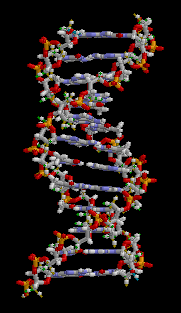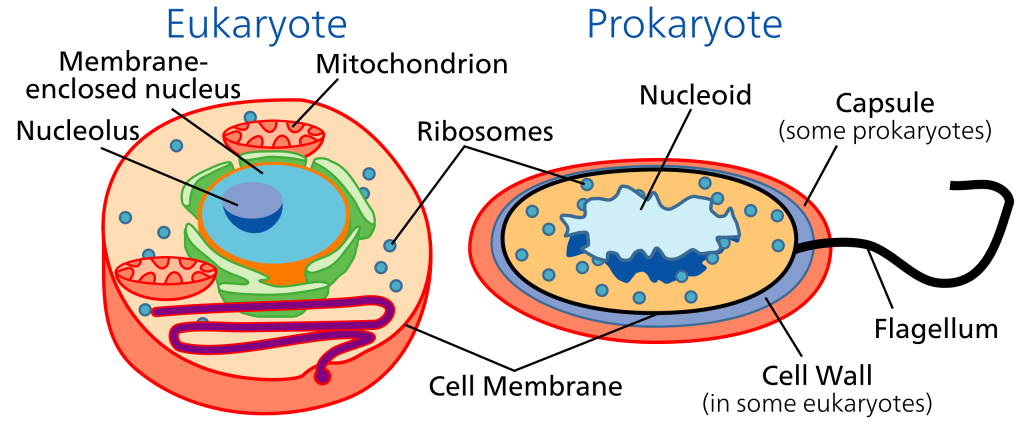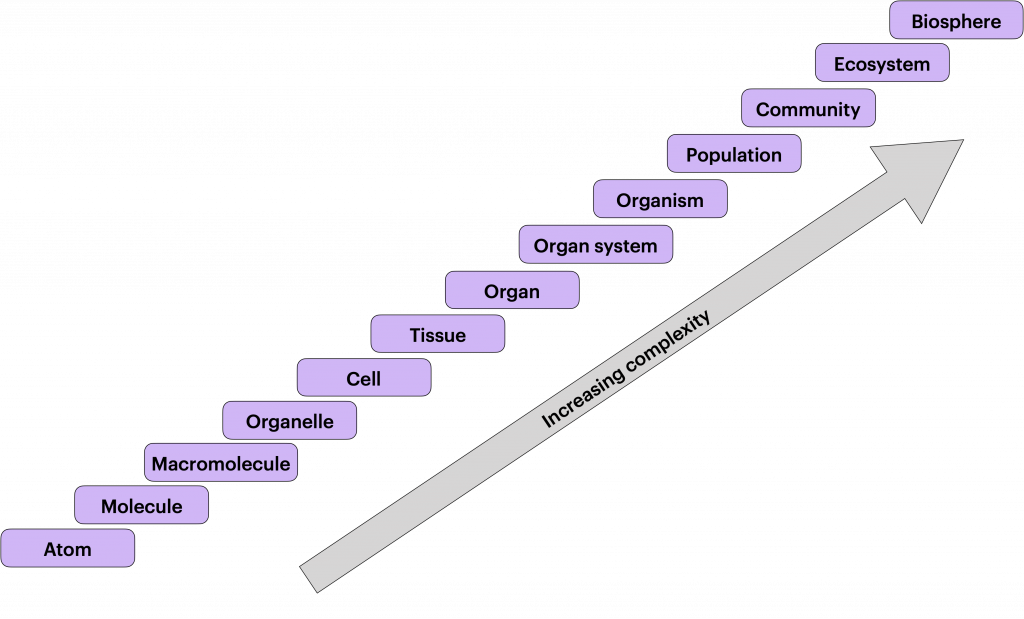1.2 Levels of Biological Organization
Organization from Atoms to Cells
Living things are highly organized and structured, following a hierarchy that we can examine on a scale from small to large. The atom is the smallest and most fundamental unit of matter. It consists of an atomic nucleus surrounded by electrons. Atoms form molecules. A molecule is a chemical structure consisting of at least two atoms held together by one or more chemical bonds. Many molecules that are biologically important are macromolecules, large molecules that are typically formed by combining smaller units called monomers. An example of a macromolecule is deoxyribonucleic acid (DNA), which contains the instructions for the structure and functioning of all living organisms.

Some cells contain organelles, which are small structures that exist within cells. Examples of organelles include mitochondria and chloroplasts, which carry out essential functions: mitochondria produce energy to power the cell, while chloroplasts enable green plants to utilize the energy in sunlight to make sugars.
Cells
All living things are made of cells. The cell itself is the smallest fundamental unit of structure and function in living organisms. Some organisms consist of a single cell and others are multicellular. Scientists classify cells as prokaryotic or eukaryotic. Prokaryotes are single-celled or colonial organisms that do not have membrane-bound nuclei. In contrast, the cells of eukaryotes do have membrane-bound organelles and a membrane-bound nucleus.

Organization from Cells to Organisms
In larger organisms, cells combine to make tissues, which are groups of similar cells carrying out similar or related functions. Organs are collections of tissues grouped together performing a common function. Organs are present not only in animals but also in plants. An organ system is a higher level of organization that consists of functionally related organs. Mammals have many organ systems. For instance, the circulatory system transports blood through the body and to and from the lungs. It includes organs such as the heart and blood vessels. Organisms are individual living entities. For example, each tree in a forest is an organism. Single-celled prokaryotes and single-celled eukaryotes are also organisms, which biologists typically call microorganisms.
Organization from Organisms to the Biosphere
Biologists collectively call all the individuals of a species living within a specific area a population. For example, a forest may include many pine trees, which represent the population of pine trees in this forest. Different populations may live in the same specific area. For example, the forest with the pine trees includes populations of flowering plants, insects, and microbial populations. A community is the sum of populations inhabiting a particular area. For instance, all of the trees, flowers, insects, and other populations in a forest form the forest’s community. The forest itself is an ecosystem. An ecosystem consists of all the living things in a particular area together with the abiotic, nonliving parts of that environment such as nitrogen in the soil or rain water. At the highest level of organization, the biosphere is the collection of all ecosystems, and it represents the zones of life on Earth. It includes land, water, and even the atmosphere to a certain extent.

fundamental unit of matter
chemical structure consisting of two or more atoms held together by chemical bonds
large molecule, typically formed by the joining of smaller molecules
a subunit that can be bound to other monomers to make a polymer
smallest fundamental unit of structure and function in living things
small structures that exist within cells and carry out cellular functions
organisms which are comprised of cells that lack a nucleus
organisms that are comprised of cells that have a nucleus
group of similar cells carrying out related functions
collection of related tissues grouped together performing a common function
level of organization that consists of functionally related interacting organs
individual living being
all of the individuals of a species living within a specific area
all of the populations inhabiting a particular area
all the living things in a particular area together with the abiotic, nonliving parts of that environment
collection of all the ecosystems on Earth

